
Prunus is a genus of trees and shrubs, which includes the fruits plums, cherries, peaches, nectarines, apricots, and almonds.

Prunus spinosa, called blackthorn or sloe, is a species of flowering plant in the rose family Rosaceae. The species is native to Europe, western Asia, and regionally in northwest Africa. It is locally naturalized in New Zealand, Tasmania, and the Pacific Northwest and New England regions of the United States.
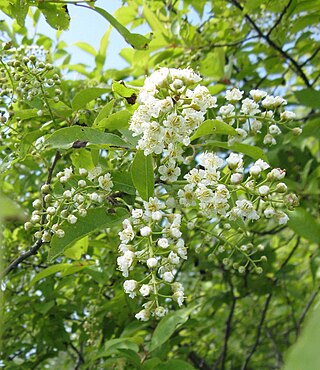
Prunus virginiana, commonly called bitter-berry, chokecherry, Virginia bird cherry, and western chokecherry, is a species of bird cherry native to North America.
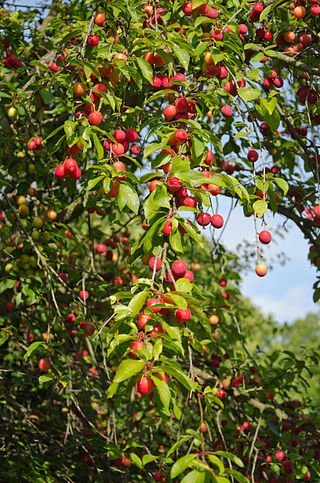
Prunus cerasifera is a species of plum known by the common names cherry plum and myrobalan plum. It is native to Southeast Europe and Western Asia, and is naturalised in the British Isles and scattered locations in North America. Also naturalized in parts of SE Australia where it is considered to be a mildly invasive weed of bushland near urban centers.

Prunus serotina, commonly called black cherry, wild black cherry, rum cherry, or mountain black cherry, is a deciduous tree or shrub of the genus Prunus. Despite being called black cherry, it is not very closely related to the commonly cultivated cherries such as sweet cherry, sour cherry and Japanese flowering cherries which belong to Prunus subg. Cerasus. Instead, P. serotina belongs to Prunus subg. Padus, a subgenus also including Eurasian bird cherry and chokecherry. The species is widespread and common in North America and South America.

Prunus maritima, the beach plum, is a species of plum native to the East Coast of the United States. It is a choice wild edible and its few pests and salt tolerance make it a resilient fruit crop for degraded lands and urban soils.

Prunus pensylvanica, also known as bird cherry, fire cherry, pin cherry, and red cherry, is a North American cherry species in the genus Prunus.

Prunus subcordata, known by the common names Klamath plum, Oregon plum, Pacific plum and Sierra plum, is a member of the genus Prunus, native to the western United States, especially California and Oregon.

Prunus nigra, the Canada plum, Canadian plum, or black plum, is a species of Prunus native to eastern North America.

Prunus americana, commonly called the American plum, wild plum, or Marshall's large yellow sweet plum, is a species of Prunus native to North America from Saskatchewan and Idaho south to New Mexico and east to Québec, Maine and Florida.

Prunus mahaleb, the mahaleb cherry or St Lucie cherry, is a species of cherry tree. The tree is cultivated for a spice obtained from the seeds inside the cherry stones. The seeds have a fragrant smell and have a taste comparable to bitter almonds with cherry notes.

Prunus tomentosa is a species of Prunus native to northern and western China, Korea, Mongolia, and possibly northern India. Common names for Prunus tomentosa include Nanjing cherry, Korean cherry, Manchu cherry, downy cherry, Shanghai cherry, Ando cherry, mountain cherry, Chinese bush cherry, and Chinese dwarf cherry.

Prunus sect. Prunocerasus is a section of the genus Prunus. Koehne originally described it as comprising the North American plums and placed it in the subgenus Cerasus. The section is now generally recognized as belonging to Prunus subg. Prunus.

Prunus avium, commonly called wild cherry, sweet cherry, gean, or bird cherry is a species of cherry, a flowering plant in the rose family, Rosaceae. It is native to Europe, Anatolia, Maghreb, and Western Asia, from the British Isles south to Morocco and Tunisia, north to the Trondheimsfjord region in Norway and east to the Caucasus and northern Iran, with a small isolated population in the western Himalaya. The species is widely cultivated in other regions and has become naturalized in North America and Australia.
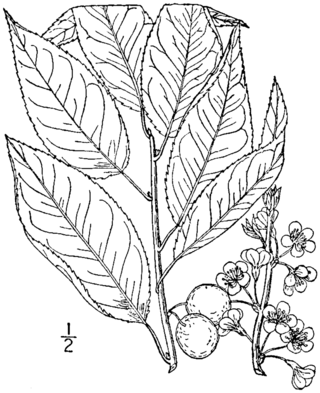
Prunus alleghaniensis, the Allegheny plum, is a species of New World plum, native to the Appalachian Mountains.

Prunus angustifolia, known commonly as Chickasaw plum, Cherokee plum, Florida sand plum, sandhill plum, or sand plum, is a North American species of plum-bearing tree. It was originally cultivated by Native Americans before the arrival of Europeans. The species' name angustifolia refers to its narrow leaves. It became the official state fruit of Kansas in 2022.
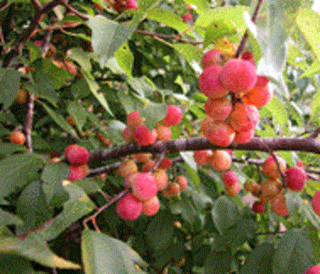
Prunus rivularis, known variously by the common names creek plum, hog plum, or wild-goose plum is a thicket-forming shrub. It prefers calcareous clay soil or limestone-based woodland soils. This deciduous plant belongs to the rose family, Rosaceae, and is found mainly in the central United States. It is a shrub consisting of slender stems with umbel clusters of white blossoms. The fruit is a drupe that resembles a large berry; though it has a bitter taste, it serves as a source of food for birds and other wildlife. "Prunus" is Latin for plum, whereas "rivularis" means being near a stream.
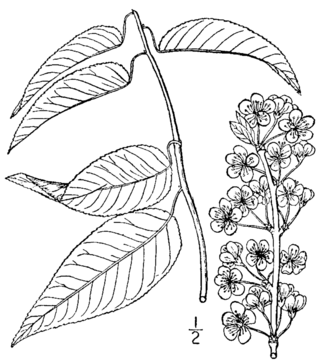
Prunus hortulana, called the hortulan plum and wild goose plum, is a fruit shrub in the rose family found in the central United States in: Arkansas, Iowa, Illinois, Indiana, Kansas, Kentucky, Massachusetts, Maryland, Missouri, Nebraska, Ohio, Oklahoma, Tennessee, Texas, Virginia, West Virginia. Populations east of the Appalachians probably represent naturalizations.

Prunus texana, called peachbush, Texas almond cherry, Texas peachbush, sand plum, peach bush, and wild peach is native to central and western Texas. Although it looks like peach, it actually belongs to Prunus sect. Prunocerasus together with other North American plum species.

Prunus minutiflora, called the Texas almond, is a shrub native to Texas and northern Mexico.






















